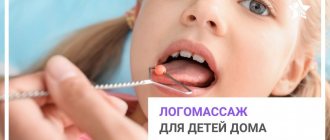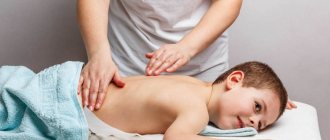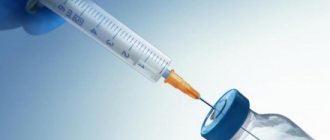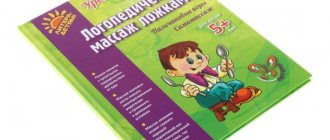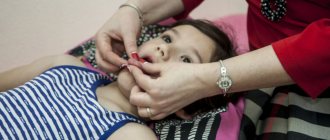Delayed speech development in a child at an early age is, alas, not uncommon, but a problem that requires a comprehensive solution, including a mandatory visit to the doctor. If the pathology is caused not by psychological constriction, but by physiological characteristics, tongue massage and articulation gymnastics are highly effective in treatment. We’ll figure out how to massage a child’s tongue, what indications and contraindications exist, and what are the features of the procedure. We remind you: before treatment, consultation with a doctor is required!
Benefits and effectiveness of baby tongue massage
Speech therapy massage is the most effective method for correcting speech defects and developmental delay problems. The acupressure complex is absolutely painless and does not cause discomfort in the child, allowing:
- reduce emotional stress;
- activate the muscles of the tongue;
- correct sounds that are difficult for children (L and R, G and D, hissing);
- get rid of stuttering and voice disorders;
- reduce saliva secretion;
- improve speech breathing performance;
- normalize muscle tone.
The difficulty when massaging the tongue is that not every baby is ready to stay in one position with an open mouth for a long time - restless children tolerate manipulation more difficult, so psychological preparation on the part of parents is especially important.
How to do articulatory gymnastics: general recommendations
- Classes should be systematic, so the necessary skills will be formed and consolidated faster. Therefore, it is better to do gymnastics daily. Try to allow at least 1 hour to pass from the moment you eat.
- The duration of the lesson should not exceed 10 minutes, and during it you should not try to do as many exercises as possible, 2-5 at a time is enough.
- Each exercise must be repeated 5–7 times. Monitor the quality of performance - if it begins to decline, this may indicate overwork.
- Holding one articulatory pose (static exercises) should be performed for 7–10 seconds.
- When selecting sets of exercises, start with the simplest ones, then move on to more complex ones. Classes should be held emotionally, in a playful way. It is best to carry them out in a sitting position and make sure that the child’s back is straight and the body is relaxed.
- You need to practice in front of a large mirror. In it, the child should clearly see the face of the adult who is working with him, and his own.
- First, the adult shows how to do the exercise, then controls how well the child performs it. Makes sure that movements are precise, smooth, and at the right pace.
- If something doesn’t work out for the child, his movements can be corrected with a pen, a teaspoon, a medical spatula, or just a clean finger.
- Be prepared that your child will not succeed in everything the first time. Try to make articulation gymnastics classes fun. Otherwise, having to do it every day will lead to a loss of interest and a decrease in its effectiveness.
Do articulation gymnastics with your child in front of a large mirror in which he can see both you and himself
Indications for speech therapy massage in children
Speech therapy massage for a child is indicated for a range of disorders, the key of which are speech problems (incorrect pronunciation of sounds, stuttering, insufficient development in accordance with age). The procedure is especially effective for a number of articulatory and even psychological disorders:
- stuttering, regardless of the cause and severity;
- partial loss of voice or minor defects;
- cerebral palsy, developmental delay;
- speech pathologies – bradyllia, aphasia, dyslalia;
- low or, on the contrary, increased tone of the facial muscles;
- dysarthria, in which the tongue is limited in mobility.
Tongue massage is prescribed by a doctor - if a parent wants to use this therapeutic method, you first need to consult with a specialist to eliminate contraindications and understand that the procedure will be beneficial.
Jaw Information
The jaws are a pair of bones that form the base of the mouth and teeth (see Figure 1).
- The maxilla is the upper jaw bone.
- The mandible is the lower jaw bone.
- The temporomandibular joint is where the lower jaw attaches to the skull.
- The masseter muscle is the muscle that connects the lower jaw to the skull.
Figure 1. Bones and muscles of the jaws
The opening and closing of the mouth is controlled by many muscles and nerves located around the jaws. Most people can open their mouth 35–55 millimeters (1.4–2.2 inches), which is the width of three fingers (see Figure 2).
Figure 2. Normal open mouth height
to come back to the beginning
How to massage a child’s tongue – procedure technique
There are several manipulation techniques, including massaging the tongue with a toothbrush - this procedure can be easily done at home. In speech therapy, special instruments, improvised means (brush or spoon), and fingers (only with gloves) are used to influence the tongue. If you plan to perform the massage yourself, follow the instructions:
- Warm up the work area by lightly stroking the skin of the face and neck - preparation will have a positive moral effect on the patient.
- Work the longitudinal muscle - you need to move from the root of the tongue to its tip.
- Walk along the transverse muscle, moving from the center to the lateral edges - being careful at the root of the tongue (causes a gag reflex).
- Perform light strokes in the oral cavity - the direction does not matter.
- Pat the surface of the tongue and again go over the longitudinal muscle.
- Treat the frenulum of the tongue with rubbing movements (you can use a gauze napkin).
The result is noticeable only with regularity - the cycle consists of 10-20 sessions (depending on the clinical picture and the achieved effect). To consolidate the therapeutic effect, take a break for 1-2 months and repeat the course.
Examples of exercises
For lips
“Smile” (lips held in a smile, teeth not visible):
My lips are flexible
They can become a smile.
“Tube” (stretch your lips into a long tube):
Let's fold our lips into a tube,
To make a pipe.
“Fence” (smile, revealing closed teeth):
We close our teeth evenly
And we get a fence.
“Donut” (round your lips and stretch them forward a little; closed teeth should be visible through the “donut”):
We depicted a bagel -
The lips were smoothly rounded.
“Piglet” (stretch your lips with a tube, move them left and right, then do a circular rotation):
Children treat the pig, its nose chooses:
On the right, red-haired Antoshka offers her potatoes,
On the left - with Zlata apples.
The pig has to choose: “Which should I choose? Should I take this?
For lips and cheeks
“Cheeks are frozen” (bite on the inside, pat on the outside, rub cheeks):
We will warm our cheeks:
Let's rub it, clap it, stomp it with our teeth.
“Fat man” (first inflate both cheeks, then one at a time):
Here's a fat man - his cheeks are puffed out
And probably hands on hips.
“Skinny” (suck in cheeks):
Here's a skinny girl - her cheeks are sunken,
Apparently they didn't let her eat.
“Ball” (puff out your cheeks, then lightly hit them with your fists):
First, inflate the balloon
Then release the air.
“Nut” (the tongue rests alternately on the right and left cheek):
The squirrel cracks nuts
Thoroughly, without haste.
We press the tongue
Left, right, sideways.
For language (static)
“Chick” (mouth wide open, tongue relaxed):
The chicks want to eat
They are waiting for mom, but they don’t make any noise.
Mom carries a grain,
Open your mouth wider!
“Hippopotamus” (open mouth wide, place relaxed tongue on lower lip):
The hippopotamus opened its mouth
He held it, then closed it.
“Cup” (open your mouth wide, the front and side edges are raised, but do not touch the teeth):
We like to drink strong tea,
Come on, put the cup down!
“Needle” (pull the tongue rolled into a tense tube strongly forward):
My tongue is like a needle,
Move away, he'll stab you!
“Mushroom” (open your mouth, stick your tongue to the upper palate):
A mushroom grew on a thin stalk,
He is neither small nor big.
Tongue sucked
A few seconds - silence!
For language (dynamic)
“Watch” (open your mouth slightly, stretch your lips in a smile. Use your tongue to alternately reach for the right and left corners of your lips):
Tick-tock, tick-tock
The clock goes like this.
“Swing” (a tense tongue alternately reaches towards the nose and chin):
Above the oak, above the spruce
We took off on the swing.
“Coil” (open your mouth, rest the tip of your tongue against the lower incisors, press the lateral edges against the upper molars. Push the wide tongue forward, then move it deep into the mouth):
Fold the tongue into a coil
And roll a toy like a cat.
“Horse” (suck your tongue to the roof of your mouth, click your tongue slowly and forcefully):
I'm a happy horse
Dark as chocolate.
Click your tongue loudly
You will hear the ringing sound of hooves.
“Jam” (lick first the upper, then the lower lip in a circle):
We ate today
Delicious jam
And now in a circle
We'll lick our lips.
Contraindications – when is tongue massage harmful to a child?
The absence of contraindications is determined by a neurologist - the doctor documents the safety of the massage for the child (manipulations at home, in a government institution, or with a private specialist are prohibited without a certificate). You cannot massage your tongue if:
- there are injuries, wounds, cuts in the oral cavity;
- diagnosed with stomatitis, gingivitis, common infectious diseases;
- the child has enlarged lymph nodes;
- the child is afraid of the procedure - often the fear is caused by the unknown and the frightening appearance of the instruments;
- there are blood supply disorders, fungal infections, cancer;
- hypersensitive skin.
Doing a tongue massage on a child with your own hands is not easy; it is better to entrust this task to a professional massage therapist - ideally a child massage therapist, since such a specialist knows how to work with children, easily finds an approach to them, and carries out procedures without hysterics or discomfort for children. Moreover, without the proper experience and skills, a parent can injure the child, cause him pain and fail to achieve the goal - the manipulations will be useless, and invaluable time will be lost.
In case of spasm of the masticatory muscles when opening the mouth
The sooner you begin treatment for spasms of the masticatory muscles, the easier it will be to resume normal jaw function. If you experience tension in your jaw, call your healthcare provider immediately. He or she may refer you to a specialist, as described below.
- See a speech and swallowing specialist, a physical therapist, or both. They will help you maintain your ability to open your mouth and regain any lost abilities. These professionals use a variety of techniques, such as exercise, stretching and massage. They may also recommend that you use special devices to help open your mouth.
- See a rehabilitation doctor. He will evaluate how well you can open your mouth. He or she may prescribe medications for pain or spasms (sudden, strong muscle contractions), suggest other treatments, or recommend medical devices to help you.
Your healthcare provider will discuss with you which specialist referral would be most beneficial for you.
to come back to the beginning
Prevention of hypertonicity of the TMJ muscles
Preventive measures against hypertonicity of the lower jaw muscles will help prevent the disease with an integrated approach. It is much easier to follow the general recommendations of doctors than to face a painful spasm of the TMJ. Prevention includes the following activities:
- Preventive visits to the doctor every six months.
- Careful systematic oral hygiene.
- Treatment of caries at its first symptoms.
- Orthodontic treatment for malocclusion pathologies.
- Disinfection of food products.
- Antitetanus therapy for animal bites.
- A set of necessary vaccinations.
- Do not open your mouth wide (jaw dislocations often occur when trying to bite off a large fruit).
- Do not overuse solid foods and do not chew nuts with your teeth.
- Avoid stressful situations, react less to stress.
Development of the disease
A provoking factor appears that causes a single muscle tension. Constant hypertonicity gradually develops into spasm. Pain weakens the muscle over time as the person tends to use the muscle less. The result is a decrease in muscle tone
. Against this background, compensatory tension of the muscle located on the opposite side of the jaw develops.
With muscle pain syndrome, the patient experiences constant pain in the area of the masticatory muscles, which intensifies with movement of the lower jaw. When closing and opening the jaws, a clicking sound is heard in the TMJ. Visually, zigzag deviations of the jaw to the side or forward are observed. Bruxism develops
. Sometimes pain syndrome manifests itself in the upper jaw, sinuses, superciliary arches, and ringing or noise in the ears develops.
Consequences of jaw spasm
Trismus is unpleasant for a person not only due to pain. When opening and closing the mouth is painful, the normal process of eating is disrupted and the gastrointestinal tract suffers. When the jaw spasms, breathing is impaired, which leads to constant oxygen starvation of the brain and headaches. This affects the composition of the blood and the functioning of the cardiovascular system.
Trismus caused by infections or tumors causes serious health problems. In this case, long-term serious treatment is required. In the initial stages, pain is completely relieved. For systemic diseases, when trismus is a secondary symptom, complex therapy is necessary.
